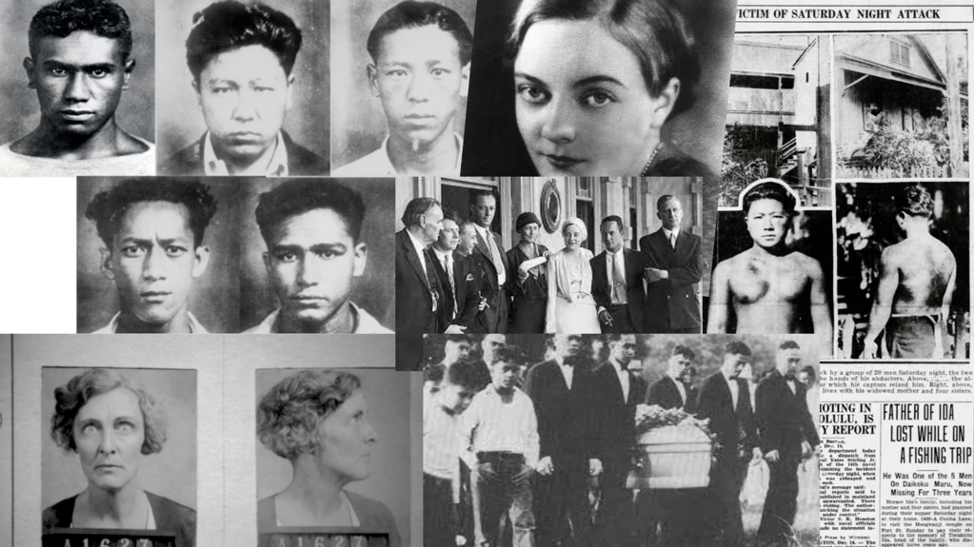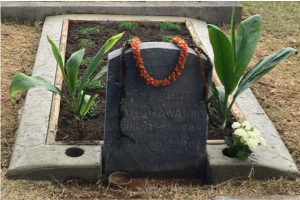#HawaiianHistoryMonth The Massie Case
September 21, 2021 Kawena Komeiji
TRIGGER WARNING: Rape and Murder
*Please note that this case is very complicated and that there are many more details to this story than can be provided in this brief summary. Check out the bottom of this blog post for resources about the Massie Case that you can use to further develop your understanding of this important and tragic event in Hawaiian history.
During the early morning hours of September 13, 1931, Thalia Massie, a 20 year-old socialite and the wife of a US Navy officer, reported to Honolulu police officers that she had just been beaten and raped by a group of men. According to Thalia, she had been attacked shortly after leaving the Ala Wai Inn, a local night club, around midnight; she claimed to have been heading to her home in Mānoa. Though her story kept changing and police had no credible details about the assailants or their vehicle, the police would soon arrest five local men in connection with the crime.
Their names were Benny Ahakuelo, Horace Ida, Joseph Kahahawai, David Takai and Henry Chang. This group of young men had gotten into some trouble the evening of September 12 – just hours before Thalia’s alleged attack – in the form of a minor road rage incident that had been reported to police.
Initially, Thalia said she could not see the car or people who attacked her but her story changed as the hours progressed, which some attribute to questionable police work that had inadvertently exposed details about the road rage incident to the Massie party. When Thalia saw the suspicion being directed at the five young men who had been involved in the road rage incident, she “identified” them as her attackers.
The young men were brought to trial despite inconsistencies in Thalia’s story and a lack of evidence, which resulted in a mistrial by a hung jury. They were released on bail. Officials in the US Navy and people in the States were outraged. Some members of the US Navy even kidnapped Horace Ida and beat him until he pretended to be unconscious.
Worried about her daughter’s reputation, Thalia’s mother, Grace Fortescue, concocted a plan with Thalia’s husband and some other US Navy soldiers to kidnap Joseph Kahahawai and beat him until he “confessed” in order to clear Thalia’s name. In January 1932, they kidnapped then shot 22 year-old Kahahawai in the chest, letting him bleed to death. Fortescue, Mr. Massie, and their party were caught by police trying to dispose of the body and led the police on a chase. They were held on a US Navy ship while awaiting trial.
This ongoing story was sensational to the American press and to audiences across the nation. Instead of being treated like criminals, the Massie party were treated like heroes. Grace Fortescue was interviewed by the New York Times while imprisoned and said her only regret was that they were caught. Fortescue was also quoted as saying, “…we were not breaking the law. We were endeavoring to aid the law. Our actions were not, to our way of thinking, illegal” (source).
When they finally went to court, Fortescue, Massie, and the others who had originally been charged with murder were convicted by a jury of manslaughter and sentenced to 10 years in prison. Facing immense political pressure, Lawrence M. Judd, Hawaiʻi’s territorial governor, immediately commuted those sentences to one hour. For the remainder of that one-hour sentence, the Massie party mingled with press to have their pictures taken and to discuss the results of the trial. Just four days later, the Massie party was taken back to the States to escape being re-tried in the Hawaiian court.
In the summer of 1932 a third-party agency, New York’s Pinkerton Detective Agency, was hired by the territorial legislature to conduct an independent investigation. Their report concluded that it had not been possible for the five men to have committed the alleged rape and assault of Thalia Massie; furthermore, they could not find any substantial evidence that she had been raped at all. All charges against the accused men were dropped in February 1933.
 Joseph Kahahawai’s funeral was attended by over 1,000 people, some of whom walked in silent protest to attend. Kahahawai was laid to rest in a cemetery in Kapālama, where his gravestone still stands today.
Joseph Kahahawai’s funeral was attended by over 1,000 people, some of whom walked in silent protest to attend. Kahahawai was laid to rest in a cemetery in Kapālama, where his gravestone still stands today.
The murder of Joseph Kahahawai highlighted racial and socio-economic disparities in Hawaiʻi, some of which continue to exist today. Kahahawai’s gravestone in Kapālama encourages us to “hoʻomanaʻo” or remember his life and story.
Library Resources
- Hawaiʻi Scandal by Cobey Black
- Honor Killing: How the Infamous “Massie Affair” Transformed Hawaiʻi by David E. Stannard
- Island Insights: Impact of Massie Case
- Local Story: The Massie-Kahahawai Case and the Culture of History by John P. Rosa
- PBS American Experience: The Massie Affair [DVD]
- What We Must Remember: Linked Poems by Christy Passion, John P. Rosa, Ann Inoshita, Juliet Kono, and Jean Toyama
Other Resources
- Kaʻiwakilomoku: Massie/Kahahawai – Native Degeneracy Revisited
- PBS American Experience: The Island Murder
-
ʻOnipaʻa: Nā Māhū Hahau Hohoa o Hāʻena
 ʻOnipaʻa: Nā Māhū Hahau Hohoa o Hāʻena
ʻOnipaʻa: Nā Māhū Hahau Hohoa o Hāʻena
4/3/2025 -
New Library Exhibits Focus on Japanese Americans During WWII
 New Library Exhibits Focus on Japanese Americans During WWII
New Library Exhibits Focus on Japanese Americans During WWII
4/3/2025 -
Spring Break Reading Recommendations
 Spring Break Reading Recommendations
Spring Break Reading Recommendations
3/4/2025